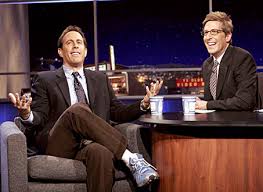The
'objective point of view' involves treating the viewer as an observer. A major
example is the 'privileged point of view' which involves watching from
omniscient vantage points. By Keeping the camera even as the subject moves
towards or away from it is an objective camera effect.
 Talk
to camera. The sight
of a person looking ('full face') and talking directly at the camera
establishes their authority or 'expert' status with the audience. Only certain
people are normally allowed to do this, such as announcers, presenters,
newsreaders, weather forecasters, interviewers, anchor-persons, and, on special
occasions (e.g. ministerial broadcasts), key public figures. The words of
'ordinary' people are normally mediated by an interviewer. In a play or film
talking to camera clearly breaks out of naturalistic conventions (the speaker
may seem like an obtrusive narrator). A short sequence of this kind in a
'factual' programme is called a 'piece to camera'.
Talk
to camera. The sight
of a person looking ('full face') and talking directly at the camera
establishes their authority or 'expert' status with the audience. Only certain
people are normally allowed to do this, such as announcers, presenters,
newsreaders, weather forecasters, interviewers, anchor-persons, and, on special
occasions (e.g. ministerial broadcasts), key public figures. The words of
'ordinary' people are normally mediated by an interviewer. In a play or film
talking to camera clearly breaks out of naturalistic conventions (the speaker
may seem like an obtrusive narrator). A short sequence of this kind in a
'factual' programme is called a 'piece to camera'.
Parallel
development/parallel editing/cross-cutting. An intercut sequence of shots in which the camera
shifts back and forth between one scene and another. Two distinct but related
events seem to be happening at approximately the same time. A chase is a good
example. Each scene serves as a cutaway for the other. Adds tension and
excitement to dramatic action.
'Invisible
editing'. This is
the omniscient style of the realist feature films developed in Hollywood. The
vast majority of narrative films are now edited in this way. The cuts are
intended to be unobtrusive except for special dramatic shots. It supports
rather than dominates the narrative: the story and the behaviour of its
characters are the centre of attention. The technique gives the impression that
the edits are always required are motivated by the events in the 'reality' that
the camera is recording rather than the result of a desire to tell a story in a
particular way. The 'seamlessness' convinces us of its 'realism', but its
devices include:
- the use of matched cuts (rather than jump cuts);
- motivated cuts;
- changes of shot through camera movement;
- long takes;
- the use of the sound bridge;
- parallel development.
The
editing isn't really 'invisible', but the conventions have become so familiar
to visual literates that they no longer consciously notice them.
Montage/montage
editing. In its
broadest meaning, the process of cutting up film and editing it into the
screened sequence. However, it may also be used to mean intellectual montage -
the justaposition of short shots to represent action or ideas - or (especially
in Hollywood), simply cutting between shots to condense a series of events.
Intellectual montage is used to consciously convey subjective messages through
the juxtaposition of shots which are related in composition or movement,
through repetition of images, through cutting rhythm, detail or metaphor.
Montage editing, unlike invisible editing, uses conspicuous techniques which
may include: use of close- ups, relatively frequent cuts, dissolves,
superimposition, fades and jump cuts. Such editing should suggest a particular
meaning.
Narration of Television
story-Covering a programme
Every item that
is broadcast must be thoroughly
researched and investigated primarily made a synopsis, it include
shooting scripts, the time schedule, appointments with various persons in the
city or outstation . Also the footage provided by the reporters on the spot is
the main ingredient of the report. It
has to be trimmed or edited for length
weeding out repetitions or irrelevant material, and then matched with the
spoken word. Inside the studio, a
variety of special effects is available, and could be used for great effect in
the presentations of the news capsules. These are slow motion, freeze, frames
speedup, rotating and burst. Each one has a specific function in the narration
and presentations if the story.
It
is up to the anchorman to choose what
he wants for maximum effects
. The anchor man has to be aware of the
kind of impact each shot will make on
the viewer, and never give in to the temptation of over emphasizing an item or a story. Everything that is broadcast has to be
edited exalt the fire, flood, accidents
house collapse or building crash.
A good editor would talked honest care to ensure that few cuts he executed do not leave jerks and disorients the viewers from the main story. The editor uses a cut away shot to maintain continuity in the narration and the flow of the story. The cut away shots were shots before or after the main incidents. Thus cut away are the most important shots in television news .
Tone.
The mood or
atmosphere of a programme (e.g. ironic, comic, nostalgic, romantic).
Formats
and other features
Shot. A
single run of the camera or the piece of film resulting from such a run.
Scene.
A dramatic unit
composed of a single or several shots. A scene usually takes place in a
continuous time period, in the same setting, and involves the same characters.
Sequence. A dramatic unit composed of several scenes, all
linked together by their emotional and narrative momentum.



















0 comments:
Post a Comment